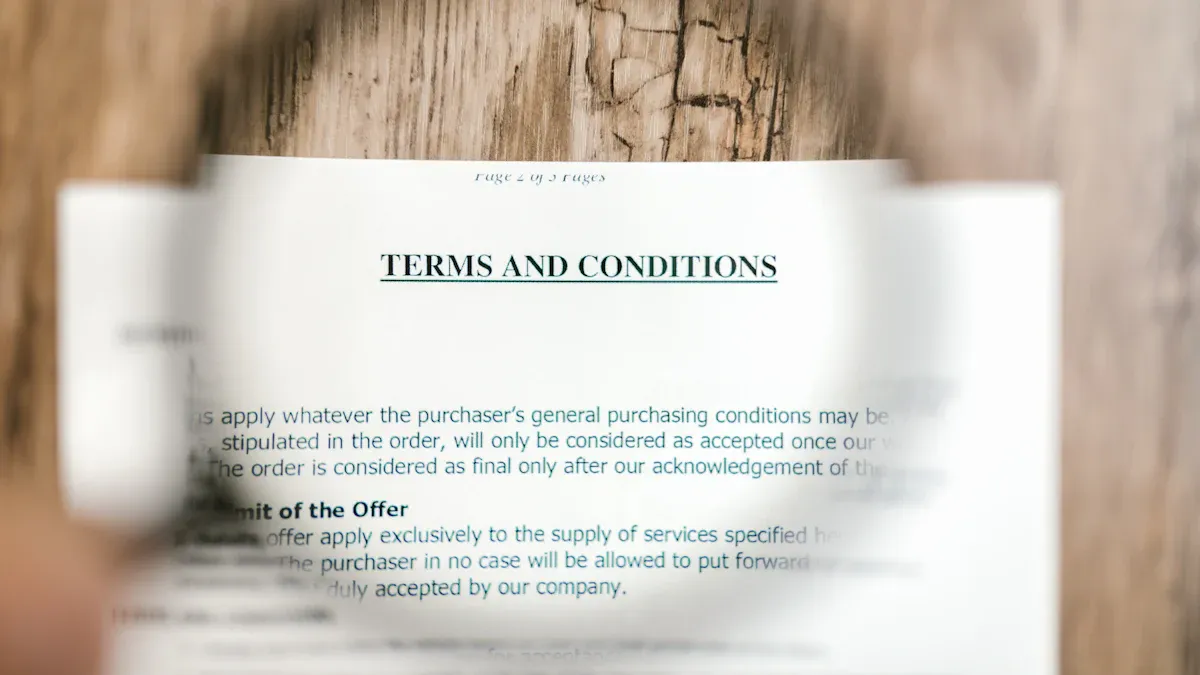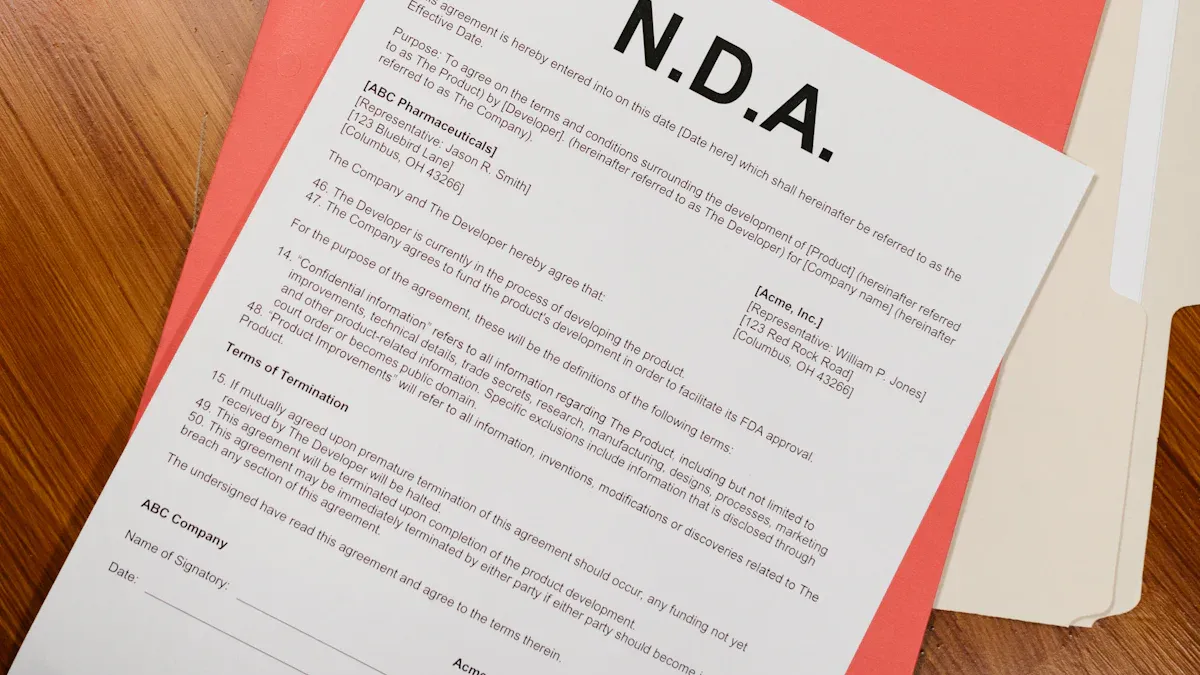
Negotiating terms with manufacturers can make or break your business. Poorly handled agreements often lead to costly mistakes. Sabías 9.2% of annual revenue is lost due to missed deadlines? Or that up to 15% of a contract’s value can vanish from compliance issues? These aren’t just numbers—they’re real risks. By preparing strategically, you’ll avoid these pitfalls. Clear communication keeps everyone on the same page and builds trust. When you approach negotiating white label agreements thoughtfully, you set the stage for smooth operations and long-lasting partnerships.
Lack of Preparation and Research
When it comes to negotiating terms with manufacturers, preparation is your secret weapon. Sin él, you risk making decisions that could hurt your business. Let’s dive into three key areas where research can make all the difference.
Understanding Market Trends and Pricing
Knowing the market is like having a map before starting a journey. Trends in private label products change quickly, and pricing strategies often follow suit. Por ejemplo, inflation has made consumers more price-sensitive, especially younger shoppers. This means you need to align your pricing with what customers expect while ensuring your product quality stands out.
Here’s a quick look at recent insights on private label pricing strategies:
Fuente | Ideas clave |
|---|---|
Private labels on the rise: Consumer trends reshaping the food and drugstore market | Align pricing with consumer expectations and reinforce product quality for revenue growth management. |
Private Label Trends: Global Market Overview | The growth of private labels is driven by inflation and consumer price sensitivity, particularly among younger shoppers. |
By understanding these trends, you’ll be better equipped to negotiate terms that reflect the current market landscape.
Researching the Manufacturer’s Reputation and Track Record
Would you trust someone without knowing their history? The same goes for manufacturers. Before signing any agreement, dig into their reputation. Look for reviews, testimonials, and case studies. A manufacturer with a proven track record of delivering high-quality products on time is worth its weight in gold.
Por ejemplo, if you’re working with a company like Oully, their certifications (FDA, ISO, CGMP) y 10+ years of experience speak volumes about their reliability. This kind of research helps you avoid surprises and ensures you’re partnering with someone who can meet your expectations.
Analyzing Competitor Strategies and Benchmarks
Your competitors can teach you a lot. What are they doing right? ¿Dónde se están quedando cortos?? By analyzing their strategies, you’ll uncover benchmarks that can guide your own approach. Look at their pricing, product quality, and even their marketing tactics.
Por ejemplo, if a competitor is thriving by offering eco-friendly packaging, you might want to explore similar options. This kind of insight not only helps you stay competitive but also strengthens your position when negotiating terms with manufacturers.
Misunderstanding the Manufacturer’s Capabilities

When negotiating with manufacturers, understanding their capabilities is crucial. Misjudging what they can deliver often leads to delays, wasted resources, and strained relationships. Let’s explore how you can avoid these pitfalls.
Assessing Production Limitations and Lead Times
Production limitations and lead times directly impact your business operations. If you don’t account for these factors, you risk missing deadlines or losing sales opportunities. Start by asking the manufacturer about their production costs and performance data.
Here’s a quick breakdown of how these metrics influence negotiations:
Tipo de evidencia | Descripción |
|---|---|
Understanding these costs helps identify areas for concessions or pricing reductions during negotiations. | |
Supplier Performance | Analyzing performance data reveals underperformance areas, allowing for better negotiation terms. |
Lead times, which measure the duration from start to finish, are equally important. Longer lead times can disrupt your supply chain and hurt your bottom line. Reducing them boosts productivity and revenue. By addressing these factors upfront, you’ll set realistic expectations and avoid surprises.
Evaluating Scalability and Capacity
Scalability is the ability to grow without compromising quality or efficiency. If your manufacturer struggles with capacity limitations, it could hinder your expansion plans. Before negotiating, evaluate their ability to handle increased demand.
Here are some key considerations:
Overcoming product capacity limitations ensures smooth scalability.
Standardizing processes before expanding resources maintains efficiency.
Developing targeted marketing and sales strategies leverages established systems for growth.
By understanding these aspects, you’ll know whether the manufacturer can support your long-term goals. This insight helps you negotiate terms that align with your business vision.
Aligning Expectations with the Manufacturer’s Expertise
Misunderstanding the white label’s additional value often stems from poor communication. Manufacturers bring specialized knowledge to the table, but you need to align your expectations with their expertise. Industry documentation emphasizes the importance of clearly communicating your needs and standards.
When you share your vision and requirements, you ensure both parties are on the same page. This alignment fosters a smoother sourcing process and minimizes misunderstandings. Treat the manufacturer as a partner, not just a supplier. Collaboration leads to better results and stronger relationships.
Failing to Clarify Roles, Responsibilities, and Expectations
When you’re negotiating terms with a manufacturer, unclear roles and expectations can lead to chaos. Miscommunication often results in missed deadlines, poor-quality products, and strained relationships. Let’s break down how you can avoid these pitfalls.
Defining Quality Standards and Inspection Processes
Setting clear quality standards is non-negotiable. Sin ellos, you risk receiving products that don’t meet your expectations. Start by aligning with recognized benchmarks like ISO 9000, GMP, or GLP. These standards ensure your white label products maintain consistent quality.
Quality Standard | Descripción |
|---|---|
ISO 9000 | A framework for quality management systems that ensures compliance. |
Buenas prácticas de fabricación (GMP) | Ensures products are consistently produced and controlled to high standards. |
Good Laboratory Practice (GLP) | Guarantees data integrity and quality in non-clinical studies. |
You should also establish inspection processes. Will you inspect products at the factory or after delivery? Decide this upfront to avoid disputes later. Clear standards and processes protect your brand’s reputation and keep customers happy.
Establishing Communication Protocols and Decision-Making Authority
Confusion often arises when no one knows who’s in charge. To avoid this, use structured communication models like DACI or RACI. These frameworks assign specific roles, ensuring everyone knows their responsibilities.
DACI Model: Focuses on decision-making authority. Roles include Driver, Approver, Contributor, and Informed.
RACI Model: Emphasizes task accountability. Roles include Responsible, Accountable, Consulted, and Informed.
Por ejemplo, the Approver in the DACI model has the final say on key decisions. This clarity prevents overlaps and keeps your white label project on track.
Addressing Delivery Schedules and Logistics
Delivery delays can derail your business. That’s why you need to discuss logistics early. Ask about metrics like On-Time Delivery (OTD) and Perfect Order Rate. These indicators reveal how reliable the manufacturer is.
Here are some key logistics metrics to consider:
On-Time Delivery (OTD): Measures the percentage of orders delivered on time.
Order Accuracy: Tracks whether the correct products are delivered.
Transportation Costs: Helps you understand the efficiency of shipping processes.
Abordando estos factores, you’ll avoid surprises and ensure your white label products reach customers on time.
Overlooking the Importance of a Detailed Contract

When negotiating a white label agreement, skipping over the details in your contract can lead to costly mistakes. A well-crafted agreement protects your business, ensures smooth operations, and minimizes misunderstandings. Let’s explore the key elements that make a contract effective.
Drafting a Comprehensive White Label Service Agreement
A white label service agreement is the backbone of your partnership. It outlines the terms, responsibilities, and expectations for both parties. Sin él, you risk confusion and potential risks of a poorly drafted contract. To create a strong agreement, focus on these guidelines:
Clearly define responsibilities to prevent misunderstandings.
Choose partners whose interests align with yours.
Build trust by maintaining strong customer relationships.
Por ejemplo, if you’re working with a manufacturer like Oully, their expertise in custom formulation and packaging design can be leveraged effectively when the agreement is clear and detailed. This ensures both parties benefit and reduces the chances of disputes.
Including Clauses for Dispute Resolution and Penalties
Disputes can arise even in the best partnerships. Including dispute resolution clauses in your contract helps you handle conflicts efficiently. These clauses reduce litigation costs and provide a clear path for resolving issues.
Consejo: Penalty clauses act as deterrents against breaches. They promote compliance and mitigate risks.
Here’s how these clauses make a difference:
They impose financial consequences for delays, ensuring deadlines are met.
They reduce uncertainties by addressing potential failures upfront.
They provide predictability in recovering compensation quickly, avoiding lengthy legal battles.
Por ejemplo, in the Sprint-Nextel merger case, multiforum litigation increased costs and uncertainty. A well-drafted dispute resolution clause could have minimized these issues.
Specifying Intellectual Property Rights and Confidentiality Terms
Your intellectual property is the heart of your brand. Protecting it in your white label agreement is non-negotiable. Manufacturers must respect your IP rights and keep sensitive information confidential.
Here’s how you can safeguard your intellectual property:
Register your IP to establish ownership and strengthen legal protection.
Require non-disclosure agreements (NDAs) from your manufacturing partners.
Implement strict access controls to limit information sharing.
Use physical and digital security measures to prevent unauthorized access.
By addressing these aspects in your contract, you ensure your brand’s unique vision remains secure. This builds trust with your manufacturer and fosters a long-term partnership.
Ignoring Long-Term Relationship Building
Building a long-term relationship with your manufacturer isn’t just a nice-to-have—it’s a game-changer. Treating them as a strategic partner, rather than just a vendor, can unlock opportunities you might not have imagined.
Treating the Manufacturer as a Strategic Partner
Think of your manufacturer as more than just a supplier. When you treat them as a strategic partner, you create a foundation for mutual success. Por ejemplo, during Hurricane Laura, Granger Chevrolet’s technology provider, CDK Global, acted as a true partner. Instead of simply fulfilling their contractual obligations, they restored critical services in under an hour, saving the dealership from a week of downtime.
This kind of partnership goes beyond transactions. It’s about shared goals and resilience. Apple’s collaboration with TSMC is another great example. By working closely, they’ve developed cutting-edge technologies that benefit both companies. When you approach your white label manufacturer with this mindset, you’re setting the stage for innovation and growth.
Investing in Trust and Collaboration
Trust doesn’t happen overnight, but it’s worth the effort. Companies that invest in trust-building often see significant returns. Por ejemplo:
Businesses that collaborate with their partners experience higher revenue due to shared R&D investments.
High-tech SMEs that work together achieve nearly four times the ROI compared to those that don’t.
Trust also reduces risks. In industries like pharmaceuticals, partnerships allow companies to share financial and operational burdens. This approach accelerates innovation while minimizing potential setbacks. When you collaborate with your white label manufacturer, you’re not just sharing risks—you’re building a relationship that can weather challenges.
Exploring Opportunities for Mutual Growth and Innovation
A strong partnership opens doors to innovation. By working together, you and your manufacturer can explore new ideas and markets. Take inspiration from organizations like ORCID and SeamlessAccess, which emphasize transparency and open communication. These principles foster collaboration and lead to groundbreaking results.
Your white label manufacturer can also bring fresh perspectives to the table. They might suggest sustainable packaging options or help refine your product formulations. When you embrace these opportunities, you’re not just growing your business—you’re helping your partner grow too. This mutual success strengthens your relationship and sets you apart in the market.
Consejo: Treat your manufacturer as a partner, not just a means to an end. The stronger your relationship, the more value you’ll both gain.
Negotiating with manufacturers can feel overwhelming, but avoiding common mistakes makes all the difference. Skipping preparation or failing to communicate clearly often leads to missed opportunities and strained relationships. Strategic preparation helps you anticipate counter-offers and secure better deals. Clear communication builds trust, uncovers shared goals, and fosters collaboration.
When you treat negotiations as partnerships, you create a foundation for mutual success. Trust opens the door to transparency and smoother discussions. By focusing on preparation and communication, you’ll set yourself up for long-term growth and stronger connections.
Preguntas frecuentes
What is the most important factor when negotiating with a manufacturer?
Preparation is key. Research their capabilities, reputation, and track record. Understand your own needs and market trends. This groundwork helps you negotiate terms that align with your goals and avoid costly mistakes.
How can I ensure my intellectual property stays protected?
Include clear intellectual property clauses in your contract. Require non-disclosure agreements (NDAs) and limit access to sensitive information. These steps safeguard your brand’s unique assets and prevent unauthorized use.
Should I treat my manufacturer as a partner or just a supplier?
Always treat them as a partner. A collaborative relationship fosters trust, innovación, and mutual growth. This approach benefits both parties and strengthens your position in the competitive white label resale market.
How do I handle disputes with my manufacturer?
Draft a contract with clear dispute resolution clauses. These clauses outline how conflicts will be managed, saving time and money. Penalty clauses also encourage compliance and reduce risks.
What’s the best way to align expectations with a manufacturer?
Communicate clearly and early. Share your vision, quality standards, and timelines. Regular check-ins and structured communication models like DACI or RACI ensure everyone stays on the same page.
















